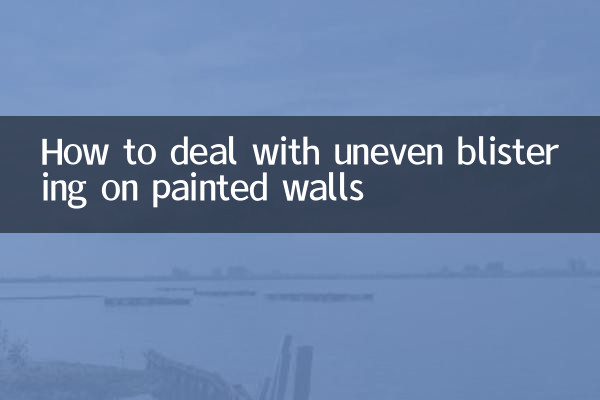How to deal with uneven blistering on painted walls
Painting walls is a common part of home decoration, but uneven or blistered walls can be a headache. This article will combine the hot topics and hot content on the Internet in the past 10 days to provide you with a detailed analysis of the causes and treatment methods of uneven and blistering walls, and provide structured data for reference.
1. Common causes of uneven and blistering walls

According to recent discussions on decoration forums and social media, wall problems mainly focus on the following aspects:
| Reason type | Proportion | Specific performance |
|---|---|---|
| Improper handling at the grassroots level | 35% | There is dust, oil or old paint on the wall that has not been cleaned |
| Construction environment issues | 25% | Construction when the temperature is too high or the humidity is too high |
| Material quality issues | 20% | Expired paint or improper water ratio |
| Construction technical issues | 15% | Apply too thickly or not enough time between coats |
| other reasons | 5% | Wall base cracks, etc. |
2. Specific steps to deal with uneven blistering on painted walls
According to the recent popular content on home decoration short video platforms, the following steps can be taken to deal with wall problems:
1.Diagnose the problem: First confirm the blistering range and unevenness. Small area problems can be dealt with locally, while large areas require complete rework.
2.Clean up problem areas: Use a scraper to remove blistered parts to a solid base, and smooth the surrounding uneven areas with sandpaper.
3.Basic treatment: After cleaning the dust, apply interface agent to enhance adhesion, and after drying, apply putty to level it.
| Material | Drying time | Things to note |
|---|---|---|
| Interface agent | 2-4 hours | Need to be completely dry before applying putty |
| putty | 24 hours | The thickness of each pass shall not exceed 2mm |
4.repaint: After the putty is completely dry, apply primer first and then topcoat, paying attention to control the thickness of the paint.
5.Later maintenance: Maintain ventilation after construction and avoid contact with water or severe temperature changes in a short period of time.
3. Precautions to prevent wall problems
According to recent popular articles on decoration public accounts, prevention is better than cure:
1.Pre-construction inspection: Make sure the wall base is solid, dry, clean, and the moisture content is less than 10%.
2.Material selection: Choose regular brand paint and pay attention to the production date and shelf life.
| Paint type | Applicable scenarios | water ratio |
|---|---|---|
| latex paint | indoor wall | 10-20% |
| waterproof coating | Kitchen and bathroom area | It is not recommended to add water |
3.construction control: Avoid construction in rainy or high-temperature weather, and the interval between each coating should be sufficient.
4.Process selection: For seriously uneven walls, consider leveling the plaster first and then applying putty.
4. Frequently Asked Questions
According to recent Q&A platform data, the high-frequency questions are organized as follows:
Q: Do all blistered walls have to be removed and redone?
A: Not necessarily. A small area of blistering can be treated locally, but if it exceeds 30% of the area or the blistering occurs repeatedly, it is recommended to redo the entire area.
Q: Can the uneven wall be polished directly with sandpaper?
A: Slight unevenness is okay, but if there are obvious unevenness, you need to level it with putty first, otherwise the base layer may be damaged.
Q: How long does it take for the treated wall to be renovated?
A: It takes 3-5 days in summer and 5-7 days in winter, depending on the paint instructions and drying conditions.
5. Professional advice
Based on the recent views of decoration experts and professionals:
1. If you encounter serious wall problems, it is recommended to consult a professional. Dealing with it yourself may be counterproductive.
2. Different brands of paint may have different construction requirements, so be sure to read the product instructions carefully.
3. Record the temperature, humidity and other environmental parameters during construction to help troubleshoot the cause of the problem later.
From the above analysis and data, it can be seen that correctly handling the problem of uneven and blistering walls requires scientific methods and meticulous operations. I hope this article can help you solve your wall troubles and create a perfect home environment.

check the details

check the details